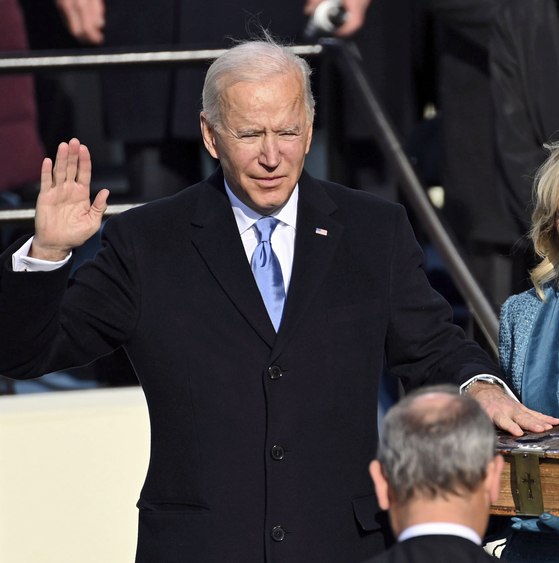
The fiscal policy of President Joe Biden, who took office on the 20th (local time), can be summarized as active economic stimulus, infrastructure investment, and eco-friendly policy. AP=Yonhap News
Active economic stimulus, infrastructure (infrastructure) investment, eco-friendly policy.
The fiscal policy of US President Joe Biden, who took office as the 46th President of the United States on the 20th, can be summarized as follows. It is a so-called’Bidenomics’ policy. A large-scale economic stimulus policy to overcome the economic downturn caused by the spread of the novel coronavirus infection (Corona 19) and investments in manufacturing, including the eco-friendly energy industry, are expected to be the main focus.
This analysis was included in the report on the’Analysis of Major Contents and Impacts of Biden’s New Government Fiscal Policy’ published in the’Overseas Economic Focus’ published by the Bank of Korea on the 24th.
① Economic recovery through massive stimulus measures

The most pressing task facing President Biden’s eyes is overcoming the recession. Last year, due to the spread of Corona 19, economic activity and consumption contracted, facing an economic crisis.
The most pressing task before President Biden is overcoming the recession. As the spread of Corona 19 last year reduced economic activity and consumption, the U.S. fell into a recession. The International Monetary Fund’s (IMF) World Economic Outlook Report, published in October last year, predicted the US economic growth rate of -4.3% in 2020.
The key prescription of the Biden administration in the face of the economic downturn is a large-scale welfare policy. It included providing various welfare services and cash to the vulnerable who lost their jobs due to Corona 19, and providing jobs through government-led projects. Through this, the plan is to solve the contraction in consumption and rerun the economic engine.
One of the representative examples is the US rescue plan of 1.9 trillion won announced on the 14th. It provides cash support of $1,400 per person, and increases the unemployment benefit from $300 per share to $400 by September.
This movement is becoming more concrete. Biden signaled a large-scale support policy on the 22nd (local time) by signing a presidential decree that ordered cash subsidies for low-income families and Supplemental Nutrition Assistance (SNAP) for children eligible for school meals.
The large-scale economic stimulus measures of $900 billion (99.45 trillion won) passed by the US Congress in December last year will be implemented one after the other in the first half of this year.
② Create jobs through infrastructure investment

Ford Motor Factory in Michigan, USA. AP=Yonhap News
Another axis of Bidnomics is government-led large-scale infrastructure (infrastructure) investment. It is to create jobs that have disappeared due to the spread of Corona 19 through government projects. To this end, the amount of financial expenditure during Biden’s tenure is expected to be about 2 trillion dollars (2210 trillion won). It is used to replace infrastructure such as lagging roads, railroads, power grids, and communication networks.
In addition, it is expected to spend a budget of 700 billion dollars (78.75 trillion won) for support measures to vitalize the manufacturing industry. The federal government plans to provide public procurement of US-made products and services to provide demand, and to create high-value-added manufacturing jobs by investing in research and development to discover future foods such as electric vehicles, 5G, and artificial intelligence (AI).
③ Fostering eco-friendly industries linked to manufacturing

Charging in’Supercharger’, a Tesla-only fast charging station in Las Vegas, USA. The Biden administration pledged to support the development of public transportation without carbon emission, install 500,000 electric vehicle charging stations, and establish an eco-friendly energy generation system. AP=Yonhap News
One of the key pillars of the large-scale economic stimulus plan promoted by the Biden government is’investing in eco-friendly industries’. Shortly after taking office, Biden signed an executive order to rejoin the Paris Climate Change Convention, and started the green policy line in earnest.
The remarkable aspect of the eco-friendly policy of Bidnomics is the connection with the manufacturing and energy industries. When the pledge is implemented, budgets are expected to be invested in supporting the development of public transportation without carbon emission, installing 500,000 electric vehicle charging stations, and establishing an eco-friendly energy generation system. As a pledge before the election, Biden promised to invest 2 trillion dollars (2210 trillion won) in eco-friendly infrastructure during the term.
Financial funding is large-scale government bond issuance…Financial soundness concerns are’limited’
The financial burden that will be put into large-scale stimulus measures, including various welfare policies, is a homework for the Biden administration. According to Moody’s, an international credit rating firm, when the Biden administration implements its pledges, it will have to spend an astronomical budget of $7.3 trillion (US$8.66 trillion) between 2021 and 30. On the other hand, the government’s income during the same period was only $4.1 trillion (45.35 trillion won), which inevitably results in a loss.
Eventually, there is no choice but to raise money by issuing large government bonds. The US government’s fiscal soundness will deteriorate, but it is predicted that the burden will not be significant. This is because if an agreement between the ruling and the opposition parties is reached, the amount of expenditure can be reduced than the original budget.
The Bank of Korea said, “Even if government debt surges unexpectedly, it is highly unlikely that it will cause a fiscal crisis in the short term.” “There is a constant global demand for US Treasury bonds, As a result, the increase in the burden of interest repayment is limited.”
Reporter Yoon Sang-eon [email protected]
